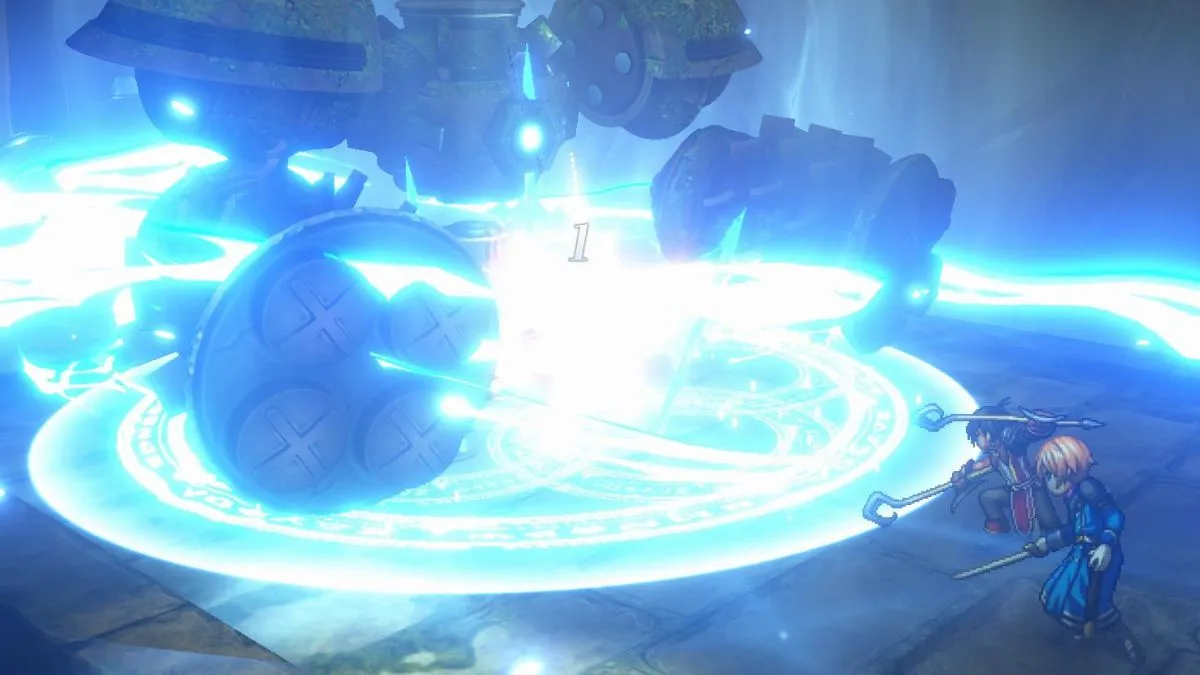
Where did my body go?
I’m standing on a mountain, and it’s snowing. When I look up, left, right, I can see snow-flakes that are small at first, then bigger as they get closer to my face. In the distance, there are mountain peaks; there’s an entrance to a hollowed-out lava pit in front of me. Then I’m inside, and rivers of lava are flowing to my left and right. There’s a menacing armored creature in front of me, and now he’s standing up. I turn my head, and I can see more snow falling through the cracks in the mountain. Light from outside is streaming through. “Look at that,” I say, pointing.
I’m sitting in a chair in a meeting room at the Los Angeles Convention Center. I’m pointing at nothing.
The phrase “virtual reality” brings to mind cheesy sci-fi inventions and failed attempts at more immersive gaming, but Oculus VR is aiming to change that with the Oculus Rift virtual reality head-mounted display. Thanks to a successful crowd-funding campaign, the developers are working towards making this VR headset available to the gaming masses… eventually. There’s no release date or price for the consumer version of Oculus Rift, but over 7,500 dev kits have been shipped, with that number expected to increase to 10,000 by the end of June. Nate Mitchell, VP and cofounder of Oculus VR, told me that developer feedback has been great, with game-makers experimenting in new and creative ways all the time.
Theoretically, there are no limits to the types of games Oculus Rift could support – first-person shooters, puzzle games, and everything in between. As part of the Unreal Engine 4 integrated partners program, the developers are running the next-gen engine on the Oculus Rift, and what’s being made now is only the “first piece of a broader platform.”
I went hands-on (or, technically, head-on) with two different Rifts: the typical dev kit and an HD prototype that will be more like what the consumer version will look like. I slipped on the dev kit, and despite the low-res visuals, I was impressed: there was a new world all around me. I could turn my head, look up, look down, see what was behind me – there was nowhere in my field of vision that this world didn’t exist. The aforementioned snowy mountain, also referred to as the elemental demo, gave me an idea of the incredible depth and immersive power of the Oculus Rift. I was describing things that didn’t exist, pointing to thin air, and it was actually a little disturbing to hear the developers talk – I had no idea what was going on in the real world anymore. The world was gone for a little bit.
Then a controller was put in my hand, and I was moving on my own. I could look with my head instead of a thumbstick, and I’d automatically walk in that direction with the controller. Oh, and I could also fly. All I had to do was look up and the controller had me floating diagonally through the air, until I reached the top of the fiery volcano. The coolness of my childhood dream of flying coming true was marred a bit by the slight motion sickness I felt, but that went away as soon as the Rift came off. I asked if that was a common issue, and Nate said it varied from person to person, but it’s a challenge they’re working to address.

As you might expect, the HD Oculus Rift looks remarkably better. The same elemental demo was suddenly sharper and clearer, and it didn’t have the distracting “screen door effect” of the lower-res dev kit. In SD and HD, though, one thing really bothered me: when I looked down where my body should be, there was nothing. Sure, it was just a tech demo, but for a true virtual reality experience I want to look down and see my body. That would really go a long way towards putting me right in that world and making me not want to leave.
There are some practical concerns for a consumer version of the Oculus Rift; aside from the potential for motion sickness, I don’t know if gamers are going to want to wear a headset like that for extended periods, and if you can’t lose yourself in a game for as long as you want, what’s the point? Practicality aside, the Oculus Rift is surprisingly cool. The sense of depth is incredible, the ability to create highly detailed 360-degree worlds is interesting, and the potential for entirely new gaming experiences is always a good thing. Whether or not the Rift lives up to this potential remains to be seen.
Additional reporting by AJ Glasser:
Eve Online developer CCP Games applies the Oculus Rift 3D headset to its franchise with a tech demo called “Eve VR.” In the experience, players equipped with OR headsets and noise-cancelling headphones are seated on a bench to experience a space fighter pilot simulation. The player’s ship is controlled both with a traditional gamepad controller (triggers fire, left stick turns the ship, A for a quick boost) and by the player turning their head to “point” the direction of their targeting reticules for lasers and missiles.
My first feeling inside the headset while waiting for the simulation to start was disorientation. I was encouraged to look up, down, left, and right to experience the act of looking around a fighter ship’s cockpit. Realistic details, like scratches on the hood and data readout screens reinforced the illusion that I was actually sitting in a spaceship. But when I looked down, I had no breasts. And when I moved my arms in real life, the arms of the virtual body I was borrowing stayed fixed to the ship’s controls.
Out in space, the act of combat prevented me from investigating my fake body. In order to seek out and fire upon other vehicles, I found myself instead looking up, left and right, trying to swing my reticule over something that would turn red. Aside from the neck strain, this part of the simulation felt like flying simulation or space fighting games I’ve played before – find something to shoot at, move forward, mash trigger buttons. Wash, rinse, repeat. The fact that I was inside of a 3D simulation was almost completely lost on me while repeating the familiar hand actions on the controller. I have a bad feeling, though, that if I had looked down and saw those lifeless hands attached to the joysticks of the spaceship, it would’ve been almost nauseatingly disorienting.
I remember reading a line in fantasy novel, Marion Zimmer Bradley’s Mists of Avalon, where a character says that you should never look back at your body if your spirit leaves it – because the body will draw the spirit back in. That’s what looking at “my” body in Oculus Rift did – it brought me back to reality. Which is the last place Oculus Rift wants its players to be.



